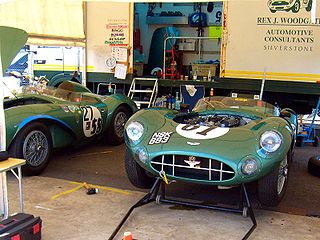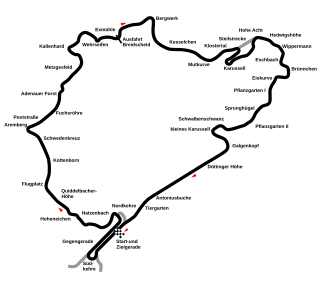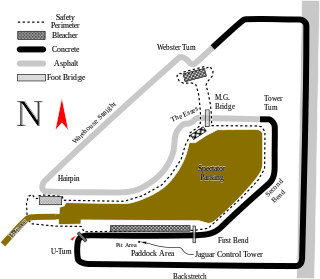The 1959 Formula One season was the 13th season of FIA Formula One motor racing. It featured the 1959 World Championship of Drivers and the 1959 International Cup for F1 Manufacturers, contested concurrently over a nine-race series which commenced on 10 May and ended on 12 December. The season also included several non-championship Formula One races.

Roy Francesco Salvadori was a British racing driver and team manager. He was born in Dovercourt, Essex, to parents of Italian descent. He graduated to Formula One by 1952 and competed regularly until 1962 for a succession of teams including Cooper, Vanwall, BRM, Aston Martin and Connaught. Also a competitor in other formulae, he won the 1959 24 Hours of Le Mans in an Aston Martin with co-driver Carroll Shelby.
Charles Anthony Standish Brooks was a British racing driver also known as the "Racing Dentist". He participated in 39 Formula One World Championship Grands Prix, competing for the first time on 14 July 1956, and achieved six wins, 10 podium finishes and 75 career points. He was third in the World Drivers' Championship in 1958 with Vanwall and second in 1959 with Ferrari. He also scored the first win by a British driver in a British car in a Grand Prix since 1923, driving a Connaught at Syracuse in 1955 in a non-championship race.

The 1959 24 Hours of Le Mans was the 27th 24 Hours of Le Mans, Grand Prix of Endurance, and took place on 20 and 21 June 1959, on Circuit de la Sarthe. It was also the fourth round of the F.I.A. World Sports Car Championship. The prospect of an exciting duel between Ferrari, Aston Martin and giantkillers Porsche was enough to draw large crowds and some 150,000 spectators gathered for France's classic sports car race, around the 8.38-mile course.
The 1957 World Sportscar Championship season was the fifth season of the FIA World Sportscar Championship. It was a series for sportscars that ran in many worldwide endurance events. It ran from 20 January 1956 to 3 November 1957, and comprised seven races.
The 1958 World Sportscar Championship was a motor racing series for sportscars which ran from 26 January to 13 September 1958 and comprised six races in six countries. It was the sixth World Sportscar Championship.
The 1959 World Sportscar Championship was the seventh FIA World Sportscar Championship. It was a series for sportscars that ran in many worldwide endurance events. It ran from 21 March 1959 to 5 September 1959, and comprised five races, following the 1000 km Buenos Aires being removed from the calendar, although the race did return in 1960.
The 1960 World Sportscar Championship was the eighth FIA World Sportscar Championship. It was contested over a five race series commencing 31 January 1960 and ending 26 June 1960.

The Aston Martin DBR1 is a sports racing car built by Aston Martin starting in 1956, intended for the World Sportscar Championship as well as non-championship sportscar races at the time. It is most famous as the victor of the 1959 24 Hours of Le Mans, Aston Martin's only outright victory at the endurance classic. It is one of only three cars in the 1950s to win both the World Sports Car Championship and Le Mans 24 Hours in the same year. In addition the six World Sports Car Championship victories was a record for any car in the 1950s and remained a record in the championship until surpassed by the Ferrari 250TR. The three consecutive triumphs in 1959 at the Nürburgring, Le Mans and the Tourist Trophy equalled the record set by the Ferrari 250TR with its three consecutive victories at the start of the 1958 season.

The Aston Martin DBR4/250, commonly referred to simply as the DBR4, is a Formula One racing car, designed by Ted Cutting for the sports car manufacturer Aston Martin. Following notable successes in sports car racing during the mid- to late-1950s — culminating in winning the 24 Hours of Le Mans endurance race and the World Sportscar Championship title in 1959 — the DBR4 was intended to repeat this success in the highest tier of open-wheel racing.

The 1953 RAC Tourist Trophy was a motor race for sports cars, held on 5 September 1953 at the Dundrod Circuit in County Antrim, Northern Ireland. It was the sixth round of the 1953 World Sportscar Championship, held just six days after the previous round, the 1000km of Nürburgring. The race was the 20th running of the RAC Tourist Trophy.

The 1954 RAC Tourist Trophy was a motor race for Sports Cars which took place on 11 September 1954 on the roads around Dundrod,. It was the 21st RAC Tourist Trophy and the fifth race of the 1954 World Sportscar Championship. The Tourist Trophy was awarded to handicap winners Paul Armagnac and Gérard Laureau driving a D.B. HBR Panhard however the overall race win for championship points was attained by Mike Hawthorn and Maurice Trintignant driving a Ferrari 750 Monza.

The 1955 RAC Tourist Trophy took place on 17 September, on the roads around Dundrod,. It was also the fifth round of the F.I.A. World Sports Car Championship, however it was the first championship race following the horrendous tragedy at Le Mans. It was also the Golden Jubilee year for the RAC Tourist Trophy. Going into the race, Ferrari were leading the Manufacturers Championship by four points from Jaguar. Victory for the Italian marque would put them in a strong position to win a third successive title.

The 3. Internationales ADAC 1000 Kilometer Rennen auf dem Nürburgring took place on 26 May 1957, on the Nürburgring Nordschleife,. It was also the fourth round of the F.I.A. World Sports Car Championship. This would the first championship since the dreadful events in the Mille Miglia, Italy just a fortnight ago, where Alfonso de Portago crashed killing himself, his co-driver and nine spectators.

The 1958 12-Hour Florida International Grand Prix of Endurance for the Amoco Trophy took place on 22 March, on the Sebring International Raceway,. It was the second round of the F.I.A. World Sports Car Championship, which was running to new regulations introduced at the beginning of the season. The most influential of these regulations changes would be the 3.0 litre engine size limit. This was seventh running of the 12-hour race.
The 42° Targa Florio took place on 11 May, on the Circuito Piccolo delle Madonie,. It was the third round of the 1958 World Sportscar Championship, which was running to new regulations introduced at the beginning of the season. The most influential of these regulations changes would be the 3.0 litre engine size limit. The event returned to the championship for the first time since 1955, following the demise of the Mille Miglia and the ban on road racing on mainland Italy. But such outcry did not deter Vincenzo Florio from holding his event on the traditional 45 mile mountainous circuit.

The 4. Internationales ADAC 1000 Kilometer Rennen Nürburgring took place on 1 June, on the Nürburgring Nordschleife,. It was also the fourth round of the F.I.A. World Sports Car Championship, which was running to new regulations introduced at the beginning of the season.

The 1959 12-Hour Florida International Grand Prix of Endurance for the Amoco Trophy was a motor race for sportscars, staged on 21 March at the Sebring International Raceway, Florida, United States. It was the opening round of the 1959 World Sportscar Championship and was the eighth running of the 12 Hours of Sebring.

The ADAC 1000 Kilometer Rennen took place on 7 June, on the Nürburgring Nordschleife,. It was also the third round of the F.I.A. World Sports Car Championship.

The 1959 RAC Tourist Trophy was contested on 5 September at the Goodwood Circuit, England. It was the fifth and final round of the 1959 World Sportscar Championship, and was the 24th RAC Tourist Trophy. The race was the title-decider in a three-way contest between Aston Martin, Ferrari and Porsche.








